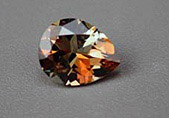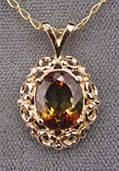
Andalusite is a strongly pleochroic gem which is largely unknown by the general public. It ranges in color from pale yellowish brown to dark green to dark brown. It's trichroic nature, which shows shades of brown, green and reddish brown depending on the path of light through the crystal, can be enhanced by specific orientation and cut. This stone has sometimes been marketed as "poor man's Alexandrite", but it is not a color change stone. The distinction being that pleochroism is seeing different colors at different viewing angles regardless of light source, whereas the color change phenomenon is seeing a change in hue due to change in light source, regardless of crystal direction.

Those cuts with a long axis such as ovals, marquis or emerald cuts tend to separate the hues so that such a gem typically shows one color near the center and a second, usually darker color near the ends. Square and round cuts usually blend the colors into a mosaic.
Most specimens contain some inclusions, the commonest of which is rutile needles. Brazil is the chief producer but Sri Lanka, Russia and the US are also sources, as is the site of original production, Spain (Andalusia). It is hard enough and tough enough for most jewelry uses. Poorly cut and polished stones are pretty dull and insipid looking, but a large, clean, well cut Andalusite is a show stopper.


Andalusite is a real gem bargain, due to its lack of recognition in the marketplace. Fine specimens can be had for less than stones of equivalent quality in many other groups. Color itself is less important in this species than the attractiveness of the pleochroic effect. Fine cutting adds value by increasing brilliance and enhancing either the color separation or mixing (both styles have their fans). As is true with ametrine, today's gem lover generally favors the blended mosaic appearance. Large stones are especially rare, any clean well cut specimen over 3 carats is a real find and will be relatively expensive.